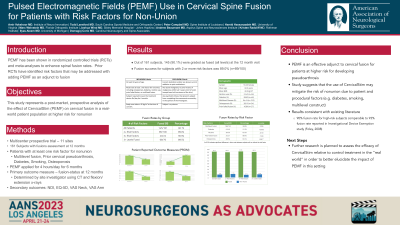Electrical Stimulation Used as an Adjunct to Cervical Spine Fusion in Patients at Risk for Nonunion
Friday, April 21, 2023


Amir Vokshoor, MD, FAANS (he/him/his)
Neurosurgeon
Institute of Neuro Innovation
Sherman Oaks, California, United States
ePoster Presenter(s)
Introduction: A multicenter postmarket prospective study conducted to examine the effectiveness of the adjunctive use of a pulsed electromagnetic field (PEMF) device on cervical spine fusion rates in subjects with risk factors for nonunion.
Methods: Patients undergoing cervical spine fusion with one or more risk factors for nonunion were enrolled from 11 investigator sites. Risk factors for nonunion included multilevel (2 or more levels) fusion, prior cervical spine fusion, diabetes, osteoporosis, or smoking. Subjects were required to wear the device for 4 hours/day for 6 months. Compliance was measured based on usage data downloaded from the device. The primary outcome measure was fusion status at the 12 month follow-up period using A/P, lateral, and flexion/extension radiographs and CT. NDI, EQ-5D, and VAS Pain (neck and arm) were collected as secondary outcome measures.
Results: Out of 161 subjects, 145 (90.1%) were graded as fused (all levels) at the 12 month visit. Over half of the subjects (61.1%) had 2 or more risk factors for nonunion. Fusion success for subjects with 2 or more risk factors was 89.0% (n=89/100). When subjects had 3 or more risk factors, the fusion rate was 90.9% (n=20/22). Subjects’ NDI score improved from a mean of 43.9 at baseline to 26.2 at 12 months (p < 0.0001). Similarly, subjects experienced improved EQ-5D scores from a mean of 0.66 at baseline to 0.77 at 12 months (p < 0.0001). Mean pain scores also improved significantly from baseline to 12 months – from 52.7 to 22.0 (p < 0.0001) and from 34.9 to 17.6 (p < 0.0001) for neck and arm pain, respectively.
Conclusion : The PEMF bone growth stimulator device is a valuable tool to aid in fusion healing, especially in challenging populations. Subjects in this study experienced favorable fusion rates of 90% and significant improvement in patient reported outcomes despite having elevated comorbidity and/or complex surgeries.
Methods: Patients undergoing cervical spine fusion with one or more risk factors for nonunion were enrolled from 11 investigator sites. Risk factors for nonunion included multilevel (2 or more levels) fusion, prior cervical spine fusion, diabetes, osteoporosis, or smoking. Subjects were required to wear the device for 4 hours/day for 6 months. Compliance was measured based on usage data downloaded from the device. The primary outcome measure was fusion status at the 12 month follow-up period using A/P, lateral, and flexion/extension radiographs and CT. NDI, EQ-5D, and VAS Pain (neck and arm) were collected as secondary outcome measures.
Results: Out of 161 subjects, 145 (90.1%) were graded as fused (all levels) at the 12 month visit. Over half of the subjects (61.1%) had 2 or more risk factors for nonunion. Fusion success for subjects with 2 or more risk factors was 89.0% (n=89/100). When subjects had 3 or more risk factors, the fusion rate was 90.9% (n=20/22). Subjects’ NDI score improved from a mean of 43.9 at baseline to 26.2 at 12 months (p < 0.0001). Similarly, subjects experienced improved EQ-5D scores from a mean of 0.66 at baseline to 0.77 at 12 months (p < 0.0001). Mean pain scores also improved significantly from baseline to 12 months – from 52.7 to 22.0 (p < 0.0001) and from 34.9 to 17.6 (p < 0.0001) for neck and arm pain, respectively.
Conclusion : The PEMF bone growth stimulator device is a valuable tool to aid in fusion healing, especially in challenging populations. Subjects in this study experienced favorable fusion rates of 90% and significant improvement in patient reported outcomes despite having elevated comorbidity and/or complex surgeries.
